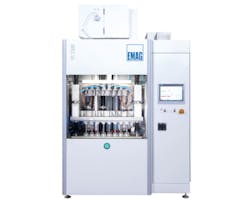Two-Barrel Electrochemical Machining for Firearms
EMAG LLC is offering a new, two-spindle ECM rifling machine that provides the same extreme precision and process repeatability as larger models but at a lower price. Firearms manufacturing requires both precision and repeatability, as the accuracy of the firearm often depends upon the minutes of angle (MOA), and the barrel is a critical factor in achieving a “perfect shot.”
Firearm barrel production combines process extremes, placing high demands on the material properties of the barrel, which must be hard enough to withstand intense forces without permanent deformation, yet soft enough to form complex geometries.
Electrochemical machining (ECM) is well-suited for this challenging application.
Barrels have different inner diameters, as well as rifling, which causes a projectile to spin and improves its aerodynamic stability. Highly detailed geometries are required in hard material machined with high precision and reliability.
The EMAG ECM special PI Rifling Machine module ensures fast and efficient barrel rifling with high precision surfaces and tight tolerances in the firearm barrel, without any mechanical or thermal stress to the barrel. The basic principle of ECM remains the same (positive anode, negative cathode and electrolyte solution), but EMAG fine-tunes a technological concept developed specifically for rifling. A narrow and elongated cathode tool generates the desired internal geometry of the barrel with precision. The electrolyte flows between the two and metal ions detach from the work piece.
Various complex geometries are possible – polygonal, progressive or standard rifling. Within the machining area, there are up to eight cathodes inside a compact module. The process is safe throughout, with easy cathode exchange and fast component loading.
“We drew on 20 years of experience in the development of ECM processes,” stated EMAG Group technical sales manager Manuel Steinhauer. “The ECM solution is suitable for short and long barrels, and almost any inner geometry is possible.”
The ECM rifling process has several advantages over alternatives. It is faster and less expensive than the hammering process, and unlike button broaching, subsequent stress relief is not needed. Additionally, the outer geometry of the blank matches the later finished geometry; whereas, for hammering, the blank is oversized at first, and then takes on desired smaller dimensions during extreme forming processes. “Contrary to hammering, the ECM process generates much less noise and vibration,” Steinhauer noted. “Our process can be used universally, unlike alternatives such as hammering or broaching. The EMAG ECM is easier to process plan and decreases reject rates.”
EMAG’s ECM solution is also quickly, thanks to its modular basic design, which is IoT-Industry 4.0-ready and easily customized. “With this technology you will produce barrels with better accuracy and MOA,” he added.
Learn more at www.emag.com
